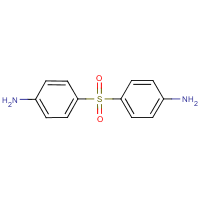Dapsone
Agent Name
Dapsone
Alternative Name
4,4'-Sulfonyldianiline
CAS Number
80-08-0
Formula
C12-H12-N2-O2-S
Major Category
Plastics & Rubber

Synonyms
4,4'-Sulfonyldianiline; 1,1'-Sulfonylbis(4-aminobenzene); 1,1'-Sulphonylbis(4-aminobenzene); 1358F; 4,4'-Dapsone; 4,4'-Diaminodiphenyl sulfone; 4,4'-Diaminodiphenyl suphone; 4,4'-Sulfonylbisaniline; 4,4'-Sulfonylbisbenzamine; 4,4'-Sulfonylbisbenzenamine; 4,4'-Sulfonyldianiline; 4,4'-Sulphonylbisbenzamine; 4,4'-Sulphonylbisbenzenamine; 4,4'-Sulphonyldianiline; 4,4-Diaminodifenylsulfon [Czech]; 4-Aminophenyl sulfone; Aczone; Aniline, 4,4'-sulfonyldi-; Araldite HT 976; Avlosulfon; Avlosulfone; Avlosulphone; Benzenamine, 4,4'-sulfonylbis-; Bis(4-aminophenyl) sulfone; Bis(4-aminophenyl)sulphone; Bis(p-aminophenyl) sulfone; Bis(p-aminophenyl)sulphone; Croysulfone; Croysulphone; DADPS; DDS; DDS (pharmaceutical); DSS; DSS (VAN); Dapson; Dapsona; Dapsona [INN-Spanish]; Dapsone; Dapsonum; Dapsonum [INN-Latin]; Di(4-aminophenyl) sulfone; Di(4-aminophenyl)sulfone; Di(4-aminophenyl)sulphone; Di(p-aminophenyl) sulfone; Di(p-aminophenyl)sulphone; Diamino-4,4'-diphenyl sulfone; Diamino-4,4'-diphenyl sulphone; Diaminodifenilsulfona [Spanish]; Diaminodiphenyl sulfone; Diaphenylsulfon; Diaphenylsulfone; Diaphenylsulphon; Diaphenylsulphone; Diphenasone; Diphone; Disulone; Dubronax; Dumitone; Eporal; F 1358; HT 976; HY 976; Hardener HT 976; Metabolite C; N,N'-Diphenyl sulfondiamide; Novophone; Sulfadione; Sulfona; Sulfona-Mae; Sulfone UCB; Sulfone, diphenyl, 4,4'-diamino-; Sulphadione; Sulphonyldianiline; Sumicure S; Tarimyl; Udolac; WR 448; p,p'-Diaminodiphenyl sulfone; p,p'-Sulfonyldianiline; p,p-Diaminodiphenyl sulphone; p,p-Sulfonylbisbenzamine; p,p-Sulfonylbisbenzenamine; p,p-Sulphonylbisbenzamine; p,p-Sulphonylbisbenzenamine; p,p-Sulphonyldianiline; p-Aminophenyl sulfone; [ChemIDplus]
Category
Curing Agents (Aromatic)
Description
Odorless white or creamy white crystalline powder; [CAMEO]
Sources/Uses
Used as an antimicrobial drug in the treatment of leprosy and a curing agent for epoxy resins;[HSDB] Also used in the treatment of malaria, Pneumocystis carinii, and some rheumatologic disorders; [Olson, p. 211]
Comments
"Some of the most commonly used curing agents in the advanced composite industry are the aromatic amines. Two of the most common are 4,4'-methylene-dianiline (MDA) and 4,4'-sulfonyldianiline (DDS). Like the epoxies, these compounds have a very low vapor pressure and usually do not present an airborne hazard unless in a mixture that is sprayed or cured at high temperatures. However, potential for dermal exposure is frequently high. The aromatic amines may permeate many of the commonly used protective gloves and thus may be particularly difficult to protect against . . . . Another of the amines, DDS, has a significant amount of toxicological data as its pharmaceutical grade, Dapsone, has been used for years to treat leprosy and certain types of chronic dermal inflammation. However, at low airborne concentrations, there are no known effects from workplace exposure." [OSHA Technical Manual: Advanced Composites] Methemoglobinemia, hemolytic anemia, and liver injury have been reported after toxic ingestion. [HSDB] The therapeutic range for adults is 50-300 mg/day. 5-12% methemoglobinemia has been reported in patients taking 100 mg/day chronically. Hemolysis has not been reported in adult patients taking less than 300 mg/day. [Olson, p. 211]
Biomedical References
Exposure Assessment
Vapor Pressure
2.68E-08 mm Hg
Explanatory Notes
Flash point > 320 deg F; VP from HSDB;
Adverse Effects
Methemoglobinemia
MetHgb is secondary toxic effect
Hepatotoxin
Hepatoxic (a) from occupational exposure (secondary effect) or (b) in animal studies or in humans after ingestion
IARC Carcinogen
Not classifiable
Diseases, Processes, and Activities Linked to This Agent
Processes
Industrial Processes with risk of exposure: